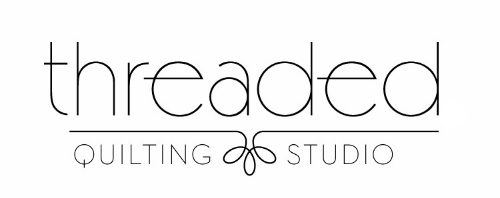I wrote the Modern Heart block pattern and photo tutorial after making it approximately 4 times. :) There's nothing wrong with that or with the instructions. But as with anything, the more times I made the block, the more efficient I became.
I'd love to share these four tips with you to increase your efficiency AND your enjoyment factor!
1. If possible, use the same sewing machine presser foot for paper piecing and block seaming.
Normally when I paper piece, I keep my papers in until the quilt is all sewn together. I usually don't need my 1/4" foot at all because I just sew on the solid outer lines of each template when seaming. With this block, I think it's much easier to remove the papers before seaming the block parts together. When you remove the papers as you go, you also remove those solid sewing lines and it becomes important to be able to sew an unmarked 1/4" seam (as with traditional patchwork).
When I began making this block, I used a special open toe foot so that I could clearly see the printed template lines of the foundation paper. When I was done with the foundation piecing parts, I switched the foot to my 1/4" foot to seam the parts together, therefore completing the block.
Eventually, after switching the feet back and forth several times, I tried foundation piecing with my 1/4" foot and guess what happened?? It was perfectly functional and more than fine. I had a clear line of vision and everything came up roses. :)
If your 1/4" foot will simply not work for foundation piecing, another idea would be to do all of the foundation piecing for ALL the blocks and then seam them all together at the end, only changing your foot once. A little "batch processing" action won't hurt. Unless you really like the satisfaction of seeing each block to completion before moving on to the next one... like I do.
2. Trim each template down to the seam allowances (dashed lines) first.
All sides of template are trimmed including the 1/4" seam allowance.
If you're having difficulty with your fabrics not covering the entire section after stitching and pressing, you might benefit from trimming around the templates first. It'll give you a better idea of position from the wrong side of the papers if you have the perimeter well defined.
Keep in mind you will still have to trim the fabrics after the sewing is completed, so pre-trimming is an extra step. However, if this simple step prevents you from having to having to touch your seam-ripper, the extra step is worth it.
Another point worth noting is that when doing any trimming around a paper piecing template, I always trim by aligning the 1/4" mark of a rotary ruler with the solid line around the outer perimeter of the template piece. I do not align the ruler edge with the dashed line as there can be inaccuracies with the placement of the dashed lines in some cases and patterns.
3. Trim the fabric covering section A1 before aligning the section A2 fabric. (The same concept applies to Part B, as well.)
Another option to begin Part A or Part B is to trim the first fabric before adding the second fabric. I'll show you with pictures:
In the photo above, I've placed my A1 fabric right side up on the back side of the template paper and secured it with one straight pin. You could also use fabric glue. I would use one securing method or the other when doing the trimming first. Placing the pin toward the bottom of the fabric and paper will allow it to stay more "out of the way" during the next step.
In this photo, you'll see that I'm following the trimming steps shown in the pattern—only—instead of trimming after a seam has been sewn, I'm trimming the first fabric before any sewing is done. This way, the angle will be in perfect alignment for the A2 fabric to be added. Actually, if you choose to follow this pre-trimming method, you really wouldn't need to cut the A1 fabric at a 45° angle at all. You could pin or glue the full 4" x 7" rectangle to the paper and trim the extra away at the exact angle in one shot.
4. Cut your fabric pieces bigger than given in the pattern directions.
People: we all have different levels of skill and experience! If you are consistently having trouble getting fabrics to cover their given sections, it might make a world of difference to cut your initial fabric shapes bigger than the dimensions given in the pattern. For example, cut your A5 fabric at 5" x 7". Sure, you'll have a little more waste, but if it helps you sew right the first time, that extra fabric is well worth it! We want this experience to be enjoyable! I'd much rather trim more away and have a little bit more waste than have to rip tiny stitches out of paper and try again. Can I get an AMEN?? :)
What about you? Do you have any other paper piecing tips to add? Please post your tip in the comments! The more I paper piece, the more I realize there is room for flexibility and adjustments, so don't be afraid to do what you need to do to have a great experience!




























